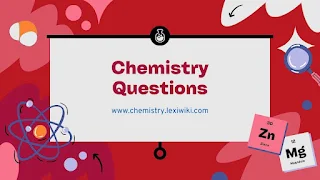Questions on Oxidation Reactions (Organic Chemistry)
20 multiple-choice questions on Oxidation Reactions in Organic Chemistry, each with five answer choices (A–E). At the end, you’ll find a complete answer key with extended explanations.
-- Ads --
Multiple Choice Questions: Oxidation Reactions (Organic Chemistry)
1. What is typically meant by “oxidation” in organic chemistry?
A) Gain of electrons
B) Loss of electrons
C) Increase in the number of C–H bonds
D) Increase in the number of C–O bonds
E) Loss of oxygen atoms
2. Which of the following functional group transformations is considered an oxidation?
A) Alcohol → Alkene
B) Alcohol → Aldehyde
C) Ketone → Alcohol
D) Alkene → Alkane
E) Carboxylic acid → Aldehyde
3. What reagent is commonly used to oxidize primary alcohols to aldehydes?
A) PCC (pyridinium chlorochromate)
B) H₂/Pt
C) KMnO₄
D) HBr
E) HCl
4. What is the product when a primary alcohol is fully oxidized?
A) Ether
B) Aldehyde
C) Carboxylic acid
D) Ketone
E) Alkene
5. What is the typical product when a secondary alcohol is oxidized?
A) Aldehyde
B) Ether
C) Carboxylic acid
D) Ketone
E) Ester
6. Which of the following reagents is a strong oxidizing agent?
A) LiAlH₄
B) KMnO₄
C) H₂
D) BH₃
E) CH₃MgBr
7. Oxidation of an aldehyde typically forms a:
A) Ketone
B) Alcohol
C) Carboxylic acid
D) Ester
E) Alkene
8. Which of the following alcohols can be oxidized to a ketone?
A) Methanol
B) Ethanol
C) 1-propanol
D) 2-propanol
E) Benzyl alcohol
9. Which of the following cannot be oxidized further under normal conditions?
A) Primary alcohol
B) Aldehyde
C) Secondary alcohol
D) Ketone
E) Alkene
10. Which class of compound is least reactive toward oxidation?
A) Primary alcohol
B) Secondary alcohol
C) Tertiary alcohol
D) Aldehyde
E) Alkyne
11. What is the role of the oxidizing agent in an organic oxidation reaction?
A) Donates electrons
B) Accepts electrons
C) Breaks bonds only
D) Produces hydrogen gas
E) Neutralizes acids
12. Which of the following reactions involves oxidation?
A) CH₃CH₂OH → CH₃CHO
B) CH₃CH₂OH → CH₃CH₂Br
C) CH₃CH₂Cl → CH₃CH₂OH
D) CH₃CH₃ → CH₄ + CH₂
E) CH₃CHO → CH₃CH₂OH
13. Which of the following statements is correct about tertiary alcohols?
A) They are easily oxidized to ketones
B) They are oxidized to aldehydes
C) They do not undergo oxidation easily
D) They are oxidized to esters
E) They form acids when oxidized
14. Oxidation of 2-butanol produces:
A) Butanal
B) Butanoic acid
C) 2-butanone
D) Butene
E) Butyne
15. Which reaction condition will oxidize ethanol to acetic acid?
A) PCC in CH₂Cl₂
B) KMnO₄ under reflux
C) NaBH₄ in ethanol
D) H₂/Ni
E) HCl in water
16. What happens to the oxidation state of carbon during oxidation?
A) It decreases
B) It increases
C) It remains the same
D) It becomes zero
E) It becomes negative
17. Oxidation of a primary alcohol using KMnO₄ yields:
A) Alkene
B) Ketone
C) Aldehyde
D) Carboxylic acid
E) Amide
18. What is the color change observed when KMnO₄ oxidizes a compound?
A) Purple to brown
B) Colorless to blue
C) Red to yellow
D) Green to colorless
E) Orange to green
19. What happens to the hydrogen atoms during oxidation of alcohols?
A) They remain in the molecule
B) They form covalent bonds
C) They are removed
D) They turn into hydroxyl groups
E) They become part of the alkyl chain
20. Which of the following statements is true regarding oxidation reactions?
A) Only occur in the presence of acids
B) Always result in the formation of esters
C) Can increase the number of carbon-carbon bonds
D) Involve the addition of oxygen or removal of hydrogen
E) Only occur at high temperatures
- Questions on Alkyl Halides (Organic Chemistry).
- Questions about Substitution Reactions (Organic Chemistry)
- Questions on Addition Reactions (Organic Chemistry)
✅ Answer Key with Extended Explanations
1. D – In organic chemistry, oxidation is typically defined as increasing the number of C–O bonds or decreasing C–H bonds.
2. B – Converting an alcohol to an aldehyde increases oxidation state, thus it's an oxidation.
3. A – PCC oxidizes primary alcohols to aldehydes without further oxidation to carboxylic acids.
4. C – Full oxidation of a primary alcohol yields a carboxylic acid.
5. D – Secondary alcohols are oxidized to ketones.
6. B – KMnO₄ is a strong oxidizing agent, widely used in organic chemistry.
7. C – Aldehyde oxidation results in a carboxylic acid.
8. D – 2-propanol is a secondary alcohol, which oxidizes to 2-propanone (acetone).
9. D – Ketones generally do not oxidize under standard conditions.
10. C – Tertiary alcohols lack a hydrogen on the carbon bearing the OH, making them resistant to oxidation.
11. B – Oxidizing agents accept electrons, facilitating oxidation.
12. A – CH₃CH₂OH to CH₃CHO is an oxidation (loss of hydrogen/gain of oxygen).
13. C – Tertiary alcohols are resistant to oxidation due to lack of α-hydrogen.
14. C – 2-butanol (secondary) is oxidized to 2-butanone (a ketone).
15. B – Reflux with KMnO₄ provides full oxidation of ethanol to acetic acid.
16. B – During oxidation, carbon's oxidation state increases as it gains bonds to oxygen.
17. D – KMnO₄ oxidizes primary alcohols all the way to carboxylic acids.
18. A – KMnO₄ changes color from purple to brown as it is reduced.
19. C – Oxidation involves removal of hydrogen atoms.
20. D – Oxidation is the addition of oxygen or loss of hydrogen, a key definition.
Dive into the groundbreaking science of neurotransmitters—your brain’s invisible architects—in Chemical Harmony: How Neurotransmitters Shape Our Lives (2025). This meticulously researched book reveals how serotonin, dopamine, GABA, and other brain chemicals silently orchestrate every aspect of your existence, from decision-making and relationships to mental health and emotional resilience.Click here to buy
Share Online!

